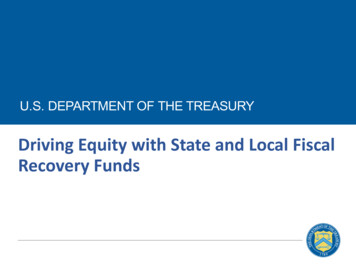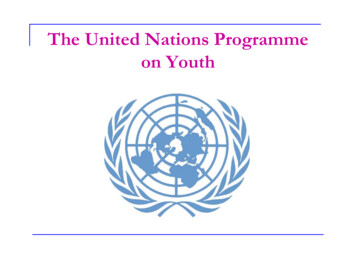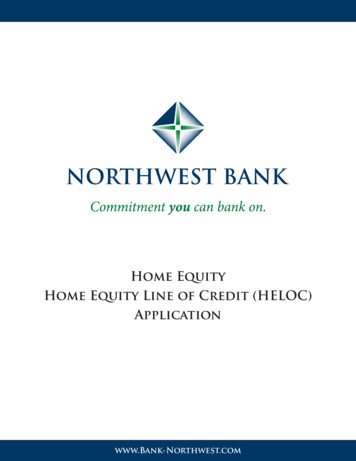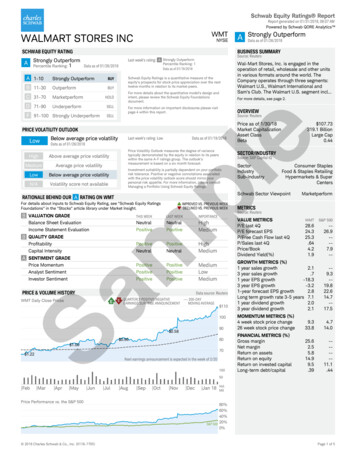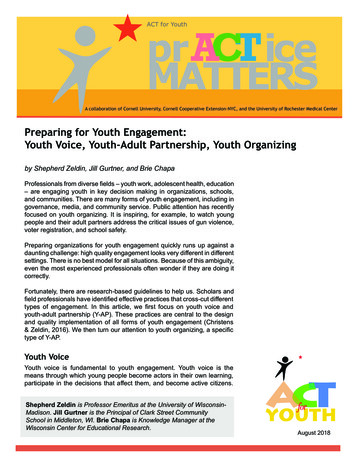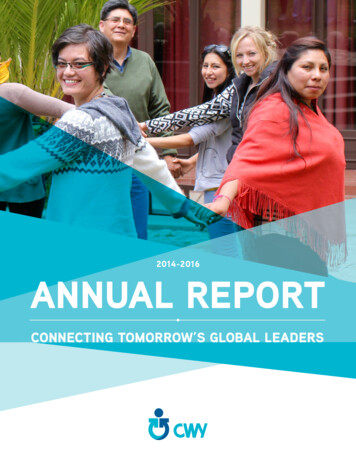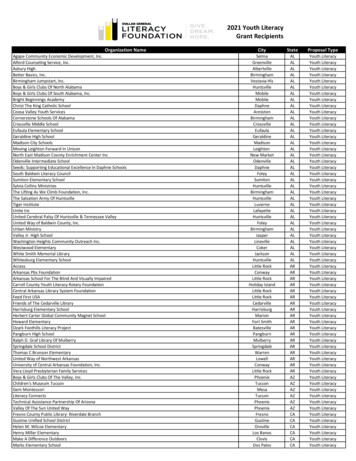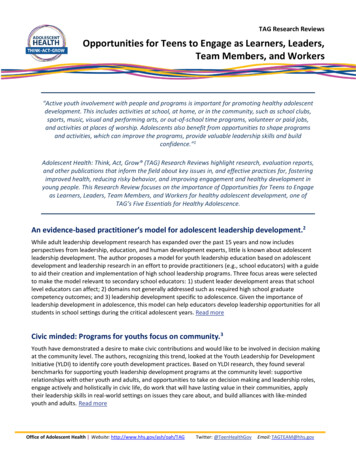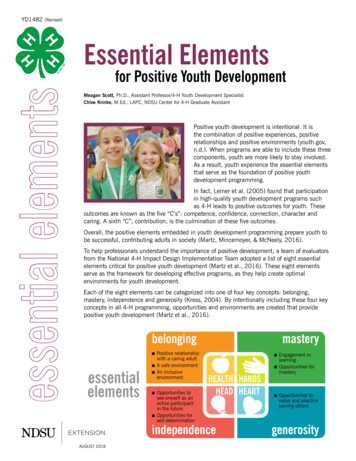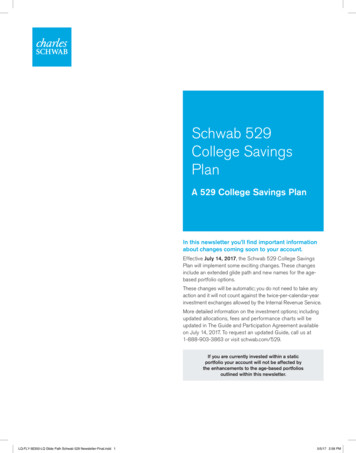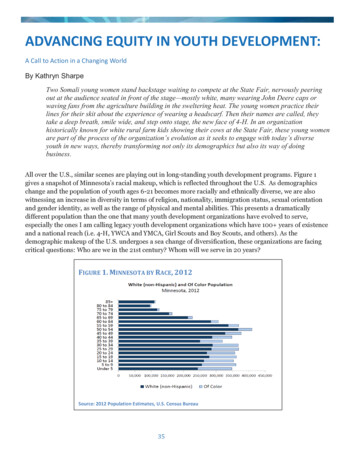
Transcription
ADVANCING EQUITY IN YOUTH DEVELOPMENT:A Call to Action in a Changing WorldBy Kathryn SharpeTwo Somali young women stand backstage waiting to compete at the State Fair, nervously peeringout at the audience seated in front of the stage—mostly white, many wearing John Deere caps orwaving fans from the agriculture building in the sweltering heat. The young women practice theirlines for their skit about the experience of wearing a headscarf. Then their names are called, theytake a deep breath, smile wide, and step onto stage, the new face of 4-H. In an organizationhistorically known for white rural farm kids showing their cows at the State Fair, these young womenare part of the process of the organization’s evolution as it seeks to engage with today’s diverseyouth in new ways, thereby transforming not only its demographics but also its way of doingbusiness.All over the U.S., similar scenes are playing out in long-standing youth development programs. Figure 1gives a snapshot of Minnesota’s racial makeup, which is reflected throughout the U.S. As demographicschange and the population of youth ages 6-21 becomes more racially and ethnically diverse, we are alsowitnessing an increase in diversity in terms of religion, nationality, immigration status, sexual orientationand gender identity, as well as the range of physical and mental abilities. This presents a dramaticallydifferent population than the one that many youth development organizations have evolved to serve,especially the ones I am calling legacy youth development organizations which have 100 years of existenceand a national reach (i.e. 4-H, YWCA and YMCA, Girl Scouts and Boy Scouts, and others). As thedemographic makeup of the U.S. undergoes a sea change of diversification, these organizations are facingcritical questions: Who are we in the 21st century? Whom will we serve in 20 years?FIGURE 1. MINNESOTA BY RACE, 2012Source: 2012 Population Estimates, U.S. Census Bureau35
As these legacy youth development organizations now seek to engage a more diverse generation, theyapproach this growth process from the context of a long historical tradition of being predominantly white,middle class, heteronormative, and U.S.-born. Their policies and practices reflect this, and they mustwrestle with their own institutional racism and other kinds of systemic discrimination as well. This requiresthem to realize that diversity and equity are not the same thing, and that simply becoming more inclusive ofdiversity is not sufficient. In a society with such dramatic disparities and inequities, these organizationsmust address equity at a deeper level, which requires them not only to shift the demographics of theirparticipants and staff , but also to change how decisions are made and resources are allocated.If we truly believe that all young people deserve the benefits of youth development programs to help themthrive, how do we need to change what we are doing in order to more equitably serve the diverse youth inthis generation? For these legacy youth development organizations to stay relevant in the 21st Centuryand engage in best practices for quality youth development, they must work to create equity in theirprograms.Many of these legacy organizations were originally created a century ago to reach out to marginalized youngpeople, such as isolated rural children of immigrant families or low-income youth living in urban tenements.Yet over time they have developed into organizations primarily serving the majority population (Russell &Van Campen, 2011). Now, as the population of youth diversifies, these organizations are seeking to servethese more diverse and marginalized1 youth, but to do so effectively requires significant self-reflection andthe willingness to change in fundamental ways. Their role in advancing equity is especially importantbecause of the significant impact they have, given their size and level of influence in youth development, aswell as the large number of youth they serve. In addition, they are also well positioned to bring togetheryouth from dominant culture and marginalized young people to build much-needed interconnectedness inour society.What brings me to this research focus is that so I am part of one of these legacy youth developmentorganizations; I have worked for over eight years at the University of Minnesota Extension Center for YouthDevelopment with the 4-H program. A major focus of my work with 4-H has been in developing strategies toreach out to and engage traditionally underserved communities, to cultivate new youth and families, torecruit and train more diverse volunteers, and to establish partnerships with organizations that serve thesecommunities. As a white, U.S.-born, middle-class, cis-gendered woman who is highly formally educated,this work has brought into high relief for me the critical importance of self-reflection about my own privilegeand employing strategies to manage it. I have found important tools for myself in this work in the emergingresearch around implicit bias and strategies for mitigating bias. As my own organization undertakes thispivot in our internal culture in order to engage traditionally underserved audiences and to create moreequitable conditions, I see how my own personal process parallels that of the historically majoritydominated organization and of my colleagues within it, as well.Therefore, I went in search of research and leaders who could shed some light on best practices, as well aspitfalls, on this journey. Because I could not take on every complex aspect of this topic, I decided to focus myresearch on the organizations’ structures, staff, and leadership. While I fundamentally believe in theimportance of being informed by youth and marginalized communities, for this study I am choosing to focuson the processes within the organization. I foresee a future companion study in conversation withcommunity members.I am using the term “marginalized” in the same way as Russell & Van Campen: “To denote the ways that some youngpeople are pushed to the margins; that emphasizes the social processes that render youth marginal, rather thanfocusing on deficits based in the person (i.e. defining youth as ‘at risk’ or ‘vulnerable’).” (Russell & Van Campen, 2011)1Kathryn Sharpe36
For this paper, I interviewed four leaders who have invested significant work into advancing equity withinyouth development organizations. Celina Martina spent 10 years as Community Partnership Director at GirlScouts of Minnesota and Wisconsin River Valleys, where she was tasked with engaging diversecommunities. Dorothy McCargo Freeman has spent her entire career in the 4-H program and now serves atthe Associate Dean of the University of Minnesota Extension Center for Youth Development and StateLeader for the MN 4-H program, where she has been working to transform it into a more diverse andinclusive program that serves all Minnesota young people. Arnoldo Curiel is the Vice President for RacialJustice and Public Policy at the YWCA Minneapolis, where he provides leadership on racial equity andpublic policy. And John-Paul Chaisson-Cárdenas serves as the state 4-H Youth Development programleader for Iowa State University Extension and Outreach, where he has spent his first two years undertakinga major initiative to diversify and build a more equitable program. Through my interviews with each ofthem, I garnered significant feedback on the paths they have taken as organizational leaders. I have alsodrawn upon my own experience as a front–line youth worker and now middle manager engaged inorganizational change and interpersonal transformation.EQUITY IN THE CONTEXT OF YOUTH DEVELOPMENTFor youth workers and youth development organizations to advance equity, it is essential for them to buildtheir intercultural competence and to address implicit biases, both as individuals and as organizations.While it is critical that we do personal work to cultivate cultural humility and to challenge our own acquiredjudgments, it is not enough. Organizations are ingrained with the racism, gender bias, homophobia, sexism,ableism, and xenophobia that the society inculcates; therefore these need to be addressed systemically. Evena group of highly culturally-responsive youth workers will be stymied if they work within an organizationwhose policies or practices are at odds with their purposes. Similarly, an organization may undertake majorsystemic changes to become more equitable, but if the staff and volunteers do not have opportunities toengage in a similar process of reflection and transformation, they can thwart the process. Therefore, for anorganization to truly transform its own ways of being and become more inclusive and equitable, the processmust include all levels of the organization engaging in a process of identifying biases and then activelyemploying strategies to mitigate them.These changes are often framed by members of dominant identities as a challenge to be tackled or as aproblem to be solved. And yet this mindset keeps us in a reactive, problem-focused mindset. Organizationsmay ask themselves, “How can we do more outreach to let people know about our program?” or “How do weget more of X community to participate in our programs?” Yet it is important that we transition from aproblem-focused approach to diversity (i.e. avoiding discriminatory practices) to a more assets-basedapproach, seeing diversity as a strategic resource to enhance an organization’s performance (Jansen, Otten,& van der Zee, 2015). We need to move toward asking, “What are the needs and desires of this community?How do we need to evolve and grow in order to partner authentically with them?”Youth development organizations are particularly well-positioned to undertake this work, since it is highlyconsistent with a positive youth development approach. We need to bring our youth developmentphilosophy and approach to our own organizational systems; we need to live the values we wish to instill inyoung people. Gisela Konopka (1973) argued in her seminal piece, Requirements for Healthy Developmentof Adolescent Youth, that we must embrace differences in the context of our heterogeneous society, and weshould promote egalitarianism as an ideal. Conversely, we must reject all forms of discrimination, since theyare destructive to all people, but especially to young people who are just establishing their identities. Inparticular, marginalized youth experience serious negative impacts on their wellbeing as a result ofdiscrimination, and youth programs are well-positioned to provide the strong interpersonal supports that37Advancing Equity in Youth Development
can serve as buffers and cultivate resilience in the face of societal discrimination (Russell & Van Campen,2011). We can approach these changes as a fertile opportunity to reflect on our practices and their result,and to consider what our new best practices might be. The policies, practices, staff, and volunteers we haveengaged so far have been successful in bringing the youth and families with whom we are currently working.But if these organizations are truly committed to engaging all youth, how can we expand the definition ofwho is included in “everyone”? How could we transform our goals, our policies, our staffing, and ourpractices to create a youth development organization that will attract and retain the full range of youngpeople in the community, and do it in a equitable way? We must engage the voices and listen to the needs ofthese under-represented audiences.ADVANCING EQUITY: BEYOND DIVERSITY OR EQUALITYI chose to focus this paper on equity within youth development organizations, understanding it is anumbrella which encompasses many aspects of diversity and inclusion. When we talk about diversity, it canbe understood as, “ [a] program looks like the population of the area where you live, work, and play. Youhave the diversity of the people” (D. McCargo Freeman, personal communication, May 27, 2016). Equality isfocused on ensuring that everyone gets the same resources or treatment: “The person at the front line hasthe same voice as the person at the top who’s making decisions” (A. Curiel, personal communication, April29, 2016). In contrast, equity instead addresses the root issues: it describes an equalizing of the balance ofpower, access to programs and opportunity, allocation of resources, and decision-making power, in additionto ensuring a diverse range of people are included:Equity/Equitable – The proportional distribution or parity of desirable outcomes acrossgroups. Sometimes confused with equality, equity refers to outcomes, while equalityconnotes equal treatment. Where individuals or groups are dissimilarly situated, equaltreatment may be insufficient for or even detrimental to equitable outcomes. An example ofequity is individualized educational accommodations for students with disabilities, whichtreat some students differently in order to ensure the equitable access to education”(Landrieu et al., 2016).This definition calls us to assess not only what we are doing in our programs, but to also focus on what theresults are, regardless of the intention of the practice or policy. John-Paul Chaisson- Cárdenas provides aconcrete understanding of why it matters that we strive for equity and not simply equality:Equity is what people need, when they need it. So it is different than equality. And in somecontexts, equality has been actually a barrier to some of the work that needs tohappen .So if we continue to [use] the common phrase, ‘Rising tides will raise all boats,’it simply does not work when you have started way below or you have an anchor attachedto you” (personal communication, May 6, 2016).Chaisson- Cárdenas expresses that as organizations take on advancing equity more is demanded thansimply increasing diversity. The work demands an assessment of how the organization’s ways of functioningmay have reinforced the inequities in society, and then the willingness to make sometimes difficult changesKathryn Sharpe38
such as in reallocating resources from an even distribution to instead allocating them where there is greaterneed (D. McCargo Freeman, personal communication, May 27, 2016). An example from my ownorganization is that 4-H has built a system of competition among youth that is focused on individualcompetition. While this has largely worked well for the European-American youth who have been themajority population, this approach does not work as well for youth from more collectivist cultures, includingmany of our immigrant communities where people value working together to achieve, rather thanhighlighting the efforts of only one member (Russell & Van Campen, 2011). In addition, families who arenew to the program might not have the resources or expertise to support their child in producing acompetitive project, so the young person may prefer to work on it as part of a group. But where canorganizations start in addressing equity? One strategy is to build cultural and intercultural competence.THE IMPORTANCE OF CULTURAL COMPETENCE IN EQUITYIn order to work to advance equity within these organizations with decades of established protocols for howthey function, which often feel exclusive to non-majority community members, they must work on twofronts: 1) fostering cultural competence and 2) addressing bias at an organizational and individual level.Later in this paper, I will take a deeper dive into implicit bias. But cultural competence is a critical startingpoint. As John-Paul Chaisson-Cárdenas asserts, “Culturally competent practice is good practice.Goodpractice is always culturally competent ” (personal communication, May 6, 2016). In the 21st Century whenworking with a large number of youth across the U.S. fundamentally requires working with youth from awide variety of backgrounds, youth development organizations must grapple with cultural competence inorder to serve the youth well. One definition of culturally competent organizations comes from MinnesotaState Colleges and Universities:A culturally competent organization values the people who work there, understands thecommunity in which it operates, and embraces its clients as valuable members of thatcommunity. The organization promotes inclusiveness, institutionalizes the process oflearning about differences and demonstrates a willingness to expand the organization’sparadigm for culture (Adapted from Moodian, M.A. (Ed.), 2008).This definition makes clear that cultural competence is something that happens at the organizational level,but also must be embodied by the individuals within that system.Ignite Afterschool, Minnesota’s statewide out-of-school time network, puts a finer point on what theprinciples of cultural responsiveness look like within a youth development context. It creates a welcomingand inclusive environment, and informs the relationships that staff members have with participants. Whendescribing programs that are responsive to culture and identity, they write, “Programs create a safe andadaptive environment which recognizes that culture, family and personal history are core to a youngperson’s identity formation” (Ignite Afterschool, 2015). This includes staff practices of creating a spacewhere young people are free to explore their identities, cultural beliefs, and practices, as well as to engagewith others’ in a way that is respectful and builds self-esteem. In addition, the “[p]rogram makes a genuineeffort to ensure staff reflect the diverse race, gender, culture, sexual orientation, language and special needsof the young people being served” (Ignite Afterschool, 2015). Therefore, cultural competence andresponsiveness calls upon us to grow in our ability to engage productively with questions of identity andculture, but also to change our practices, such as hiring and retaining a diverse workforce.39Advancing Equity in Youth Development
Some people argue that rather than leaning into difference of culture and identity, we should instead adopt a“colorblind” policy as a way to promote fairness and equality among all people, regardless of identity orbackground. Yet some studies have found that colorblindness can actually reinforce inequity. In educationalsettings, colorblind approaches (treating race as taboo or invisible) can actually mask discriminatoryclassroom practices or school policies (i.e. racial disparities in school discipline if the school does not trackincidents of discipline by the race of the student). In addition, teaching children in a colorblind mannermakes them less likely to perceive discrimination when it occurs, and it deprives them of learning thelanguage they need in order to communicate effectively about a situation that involves racial discrimination.Similarly, adults with colorblind attitudes are less likely to perceive workplace micro-aggressions (Plaut,2014). The fundamental flaw of a colorblind approach is that it completely dismissed the fact that oursociety and so many of its systems are not colorblind, and that people have profoundly different experiences(e.g. in hiring, policing, disciplinary action, or housing) based on their race or other aspects of their identity.So how can we expand the sense of “us” within an organization in order to be inclusive of more diversity,especially in organizations whose staff might not currently reflect the full diversity of the community, andwho may not all be on board with the changes necessary to engage youth in the 21st century? One strategyshown to be effective through research is called all-inclusive multiculturalism. This approach includesmajority members in the definition of multiculturalism, and research has shown it to be more effective thantraditional multiculturalism approaches at getting support from members of the majority (Plaut, 2014). Thisstrategy is not simply about making white or other majority members feel more “comfortable,” but ratherabout helping everyone find their shared common ground. Employing this approach may be particularlyhelpful in organizations with a high percentage of majority staff members. For example, some organizationshave embraced “1st Generation” initiatives, focusing both on traditionally-underserved communities and onfamilies who have never been involved in their programs. “[T]hat’s why we have named it ‘1st Generation’,because that takes in more broadly than ethnicity, but it also helps us to see our idiosyncrasies that make itless inviting or less welcoming to young people. So the approach is to recognize that there is stuff thatkeeps all people from feeling like they are part of us” (D. McCargo Freeman, personal communication, May27, 2016). This initiative has been highly successful in engaging staff members from rural, vastly majoritywhite communities so that they can see themselves in the work of inclusion. This example illustrates whatstudies have found: that an all-inclusive multiculturalism approach increased a sense of inclusion for allorganization members, and this inclusion, in turn, predicted more support for organizational diversityefforts by majority members (Jansen et al., 2015; Plaut, 2014). At the same time, however, it is essential toacknowledge that changing policies and practices to make them more welcoming to new members of themajority community will not necessarily translate to marginalized communities. A 1st Generation initiativeshould not be seen as a way to side-step critical issues such as race and ethnicity, for example. It cannoterase the differences in experience of youth of color, Native youth, disabled youth, or LGBTQ youth.Addressing often well-entrenched policies and practices requires assessing the impacts they have had, andthat process leads us to recognizing the role of implicit bias.WHEN WE DON’T EVEN KNOW WHAT WE ARE THINKING: IMPLICIT BIAS AND ITS ROLE IN EQUITYNeurosocial research has revealed that human beings are influenced constantly by both positive andnegative subconscious associations about others, based on characteristics such as race, gender, age, accents,and many other aspects of our identity. This phenomenon is known as implicit bias and has significantimplications in our behavior and judgments. Implicit, or unconscious, biases occur involuntarily and arebeyond both our awareness and our conscious control (Staats, Capatosto, Wright, & Contractor, 2015). Infact, they often are contrary to what we think we believe. The brain naturally has two major systems forthinking: System 1 is quick, instinctive, happens in the back of the brain with little effort, and tends to beKathryn Sharpe40
highly biased because it is based on inputs from the world around us. System 2 thinking is slower, occurs inthe front of the brain with more effort, and can serve as a brake on System 1’s bias, allowing us to questionour own judgments (Staats, 2015). While everyone has implicit biases, the good news is that we can addressthem and even mitigate their effects (Lieberman, Rock, & Cox, 2014).Youth development organizations are uniquely well-positioned to do the work of addressing implicit biasbecause it is consistent with the process of youth development. Based on what neuroscience is teaching us,addressing implicit bias requires us to utilize the inherent plasticity of the brain, interrupting existing neuralnetworks of unconscious judgments, engaging in intentional reflection, and establishing new neuralnetworks employing the “System 2” thinking using the prefrontal cortex. The same brain plasticity that weare working with in educating young people is also our best tool in addressing and reducing implicit biases(J. P. Chaisson-Cárdenas, personal communication, May 6, 2016). So how can we address implicit bias inorder to advance equity in legacy youth development organizations?THE POWER TO MAKE CHANGE FOR EQUITYAs organizations address implicit bias to advance equity, we must address the question that Celina Martinaposed: “What is the intersection of power and equity? Is it that only power can propel effective equity work?Can equity happen organically without a power structure, without the forces of power?” (personalcommunication, May 23, 2016). This power can come from leaders who have positional power within aninstitution or from a movement among the grassroots staff and volunteers. But ultimately they must work atboth the organizational/policy level and the individual staff/practice level. Chaisson-Cárdenas expressedthis interconnectedness between individual and organizational change:[I]t is both/and. I mean, we are trying to change the culture. It’s not only a system. If yougo back to the research on implicit bias, it is individual, but the same processes areparalleled within a system because systems are living organisms. So the biases ofindividuals extend up to the biases of the organization. You cannot separate those. Anytime you try to separate those is when you get in trouble. That is why training has to gohand-in-hand with the policy change. It is the ‘so what?’ of policy change (personalcommunication, May 6, 2016).Training can help staff and volunteers to engage in personal reflection, confront their unconsciousjudgments, and transform their habits of thinking. The changes, however, must be addressed at multiplelevels of the organization because if they are not, policy-level changes that are not supported by the actionsof staff will be empty policies, and conversely, staff who transform their attitudes and practices will findthemselves running up against inequitable policies. I will lay out strategies for building equity andmitigating implicit bias that can be applied by people at various levels within the organization.PROVIDING LEADERSHIP FROM THE TOP: ENGAGING IN ORGANIZATIONAL-LEVEL CHANGEPeople in a position of organizational leadership can make a powerful contribution to the work of advancingequity and addressing implicit bias by setting it as a key priority, inspiring change, and establishingaccountability. Chaisson-Cárdenas stated:41Advancing Equity in Youth Development
I think really [taking] things from a systemic approach has been very successful, and so Ithink we are starting to change the tone and the culture of the organization. And I wouldsay, actually, we took it from the top-down. At the beginning I was the flag bearer forequity and inclusion. And it’s not because there’s not great allies or folks in theorganization, but because I felt that it really does have to [come from] the State Leader fora reason .But little by little, it began to be saturated or consumed by really wonderfulfolks in our organization It is the buy-in that really makes the difference (personalcommunication, May 6, 2016).He makes a strong argument for the role of a leader with positional power who can work on multiple facets:lead the strategy, spearhead execution, and establish accountability. Celina Martina explains further theorganizational dynamics that make it advantageous to have a leader: [I]n my successful experiences working with equity, there is a level of power that has tobe there in order to move the work forward. So whether it is a designated staff, whether itis a leader within a department, or even a youth participant that works toward that, it hasto be assigned. It is work that has to be assigned and defined because [otherwise] it isoverlooked and we are sucked into the current systems. So by dedicating money, time,staff, salary, title we move towards equity work versus trying to have it happenorganically. It may happen organically by some, by movements of people, but it isharder it is just hard to overcome some barriers. Because the organic movements ofequity work also have to know how to navigate the system, so within that movement alsothere is a leader (personal communication, May 23, 2016).She highlights the fact that much of equity work depends on navigating systems of power so as to changethem, and while this can happen from the grassroots, it is more efficient if it happens from a leadership levelwith positional power. This is the level at which HR policies and hiring decisions can be analyzed for theirimpact and changed as necessary. For example, if one of the qualifications for a job is having previousexperience in the organization, and if the organization lacks diversity, then that is an inherent barrier tohiring more diverse staff. Simply by removing that expectation, an organization can transform its staffing (J.P. Chaisson-Cárdenas, personal communication, May 6, 2016).The danger, however, of having efforts led by someone who is designated as the leader, either an individualor team, was expressed by all of my interviewees: the leader can become the scapegoat if things do not gowell; they can be overloaded and under-resourced; their colleagues can see them as the “experts” to whomeveryone else then defers; or it can be seen that equity work is “their work,” rather than work on everyone’splate. McCargo Freeman suggests a way to counteract this danger: “My vision is that everyone is responsiblefor [equity]. The organization has to set a responsibility. But the leader can’t make it happen until everyonein the organization is expected to drive that vision forward” (personal communication, May 27, 2016).Chaisson-Cárdenas describes how equity work is operationalized throughout their program: “It’s a jobexpectation that got included in everyone’s position description, so there is nobody who doesn’t have it inour system now as part of their work. If they’re not doing it, then we’re going to have words It’s a big partKathryn Sharpe42
of their review” (personal communication, May 6, 2016). This approach of collective accountability wasagreed upon by each of my interviewees as critical for truly transforming the culture and functioning of anorganization.One of the most effective roles that a leader for equity can play is that of “disrupter,” using their role to posecritical reflective questions to engage peopl
Youth development organizations are particularly well-positioned to undertake this work, since it is highly consistent with a positive youth development approach. We need to bring our youth development philosophy and approach to our own organizational systems; we need to live the values we wish to instill in young people.
